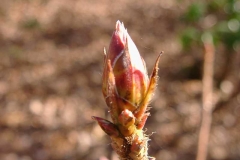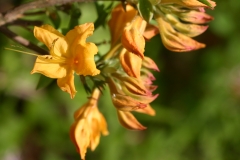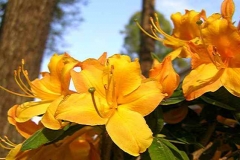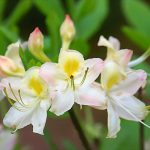
The deciduous species often coexist in isolated areas. Natural hybridization occurs, making taxonomy difficult. The attached presentation--by Charles Andrews, VP of the ASA, provides an insight into this phenomenon. Is about 9Mb, a PowerPoint presentation shown here in PDF.

Frank L. Abbott of Bellows Falls, Vermont was a pioneer in the creation of hybrids using Rhododendron prinophyllum, molle, calendulaceum, and arborescens. He developed a group of very cold hardy azaleas—to -25°F or lower. While he named several of them, others were sold as seedlings and named by others—see Carlson and Weston hybrids.
An extensive source on Abbott and his hybrids is “Frank Abbott’s Village of Azaleas”, by John and Sally Perkins, Salem, NH, http://rosebayblog.blogspot.com/2009/09/abbott-azaleas.html. Abbott gave plants freely to friends and neighbors in Saxtons River, VT and the Perkins were able to find and photograph many of the Abbott hybrids while touring the vicinity.
John and Sally Perkins have done extensive study of the ploidy of the Abbott hybrids. ‘Margaret Abbott' (prinophyllum (diploid) X calendulaceum (tetraploid)) is a tetraploid. 'Margaret Abbott' is a Tetraploid, http://rosebayblog.blogspot.com/2011/06/margaret-abbott-is-tetraploid.html. 'Margaret Abbott' was named by Frank to honor his wife. Frank was amazed he crossed a pink with a yellow to produce this lone fragrant ruffled white flower with a yellow flare.
Those wishing an introduction to ploidy in azaleas should read Rules of Engagement: Have Pollen - Will Travel by John and Sally Perkins, Salem, NH, http://rosebayblog.blogspot.com/2009/12/rules-of-engagement.html, and also “Exploring the Ploidy” by John and Sally Perkins, https://azaleas.org/wp-content/uploads/azalean/37/12/articles/Exploring_the_Ploidy.pdf
no images were found

Ivan and Robertha Arneson of Canby, Oregon were schoolteachers who had a farm—which gradually filled with a variety of brightly colored Mollis and Exbury azaleas. In 1959 they began a breeding program to develop better bright, clear-colored flowers. They worked largely with the Mollis and Exbury hybrids and seedlings, working to produce brilliant reds and other intensely-colored blooms. By the 1980s they were developing 100 crosses per year and selling 20,000 plants. With the advent of tissue culture they worked with Bruce Briggs to bring some of their crosses into production. Read their article from JARS for more details and a list of hybrids as of 1995: Ivan and Robertha Arneson, JARS v29n1 - Hybridizing for Superior and Unique Azaleas

aromi deciduous azaleas
The Aromi azalea hybrids were created in Mobile, Alabama by Dr. Gene Aromi, a retired education professor at the University of Southern Alabama, and his wife Jane, a retired elementary school teacher. As documented in the Summer 2003 issue (25:2) of The Azalean, they began their hybridizing program in 1969 to develop evergreen azaleas with "large flower size, early bloom time, improved bud hardiness, compact habit, and array of flower forms, and rich colors". They have named 31 evergreen azalea hybrids, described on our Aromi evergreen page.
In 1971 they began hybridizing Exbury azaleas with southern native species to create heat tolerant, large flowered, fragrant deciduous azaleas. Over 100 of these deciduous hybrids are named, and 8 of them are registered (shown in the list with an ® after the name).
They numbered the first selection from the first cross A-1, the first selection from the second cross B-1, and so on. Thus, for example, AAY-3 is the third selection from the 26+(26*26)+25 = 727th cross.
Other accounts of the Aromi's hybridizing programs are in the September 1999 issue (21:3) of The Azalean, and the Winter 2002 issue (56:1) of the Journal of the ARS.

The Confederate Series of Native Azaleas were selected from a cross of Rhododendron austrinum and Rhododendron x 'Hotspur Yellow'. This cross was made by Bob Schwindt at Dodd & Dodd Nurseries in Semmes AL, the seed were planted by Tom Dodd Sr. and Tom III made the evaluations and named them per Mr. Schwindt's request. The Exbury Azaleas couldn't take the heat of the deep south. The R. austrinum blood gives them the heat tolerance and vigor that we need here. Below is a list with the colors, etc. Most of them are difficult to propagate and grow, but do well once they are planted in semi-shade with good drainage. (Click the thumbnails for larger images.)


























